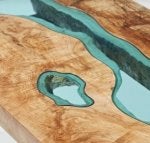Whatever else you do, if the edge of the glass is exposed, it must must be sanded so it is no longer sharp. Glass shops use a thin sanding strip on a machine for this purpose. They hold the glass up to the moving sandpaper strip, moving it rapidly to avoid heat buildup or breakage. I would never consider handling raw edged glass without leather gloves and would wear gloves when sanding the edge down in case it shattered. Glass always has some internal stresses you can't see.
If the glass is thick, then a polished wide bevel on the edge is a good choice, but more complicated to create. For safety, all glass, beveled or not, needs to have all edges sanded, top and bottom.
I agree with the others, to have a piece of glass level with the wood top, you need to use a mortising bit as shown in a previous post. These have a bearing so you can use a straight edge or pattern to guide them. A mortise is really just a very shallow rabbet or groove. With glass you either have to do this to the parts before assembly, or use a chisel to square up the corners on an assembled piece.
Make that an extremely sharp chisel. A good example of what I'm talking about is the mortise you make to install a door hinge flush with the door's jamb. You generally don't need to pound on the chisel, it is more of a carving operation. Cut the edges first, then carefully carve out the waste. I recently replaced three interior doors and reset an exterior door, using a small mortising bit with a pattern, then a chisel to square them up for the hinges. Take your time. No rush.







